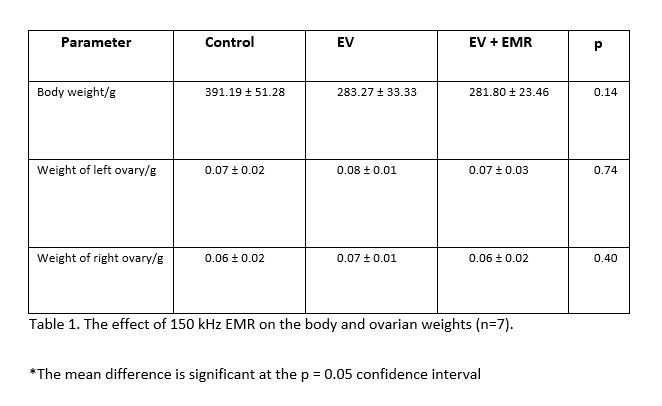Results
Effect on body and ovary weight
The body weights measured at the end of the experiment revealed that the mean and standard deviation had reduced significantly when animals were given EV regardless of exposure. However, there was no significant difference among the EV group and the exposure group with regards to body weight. Additionally the weight of the left and right ovary did not vary significantly among all three groups (Table 1).

Effect on estrous Cycle
All three groups showed normal estrous cycle prior to the experiment. During the experiment, the normal estrous cycle of 4-5 days with all four phases was observed in the control group, whereas it was disrupted in EV induced group with a dominant estrous stage (many cornified cells). The EV+ EMR showed less cornification stages with improved estrous cycle than the EV group (Figure 2).
Effect on Histological structure of Ovary
The ovarian follicles at different stages of development were normal and intact for the control group. The preantral and antral follicles revealed signs of degeneration, including cell pyknosis, thin granulosa cells layer, numerous cystic follicles, thickened theca layer, distorted zona pellucida and cumulus oophorous and blood congestion and reduced number of CL in EV group rats. The EV + EMR group showed little signs of distortion from the antral follicle to the mature follicle. Follicles at various stages were observed for this group (almost similar to the control), with a smaller number of cysts present (Figure 3).
Histomorphometrical Analysis
The histomorphometric analysis of ovarian follicles in the control, EV and EV+EMR groups are presented in (Figure 4). In the EV group, a significant decline was observed in the number of preandral follicles whereas, the number of antral follicle and cystic follicle increased in number compared with control and EV+EMR groups. The number of atretic follicles did not show any significant difference among the groups. In EV+EMR group, the number of ovarian follicles at the different stages of development were closely similar to the control group. The number of corpus luteum was lower in the EV group and highest in the EV + EMR among all three groups. The mode number of follicular cysts per ovary in the EV group was higher than all groups as each rats presented with at least 2 cysts with inner diameter > 40mm. Two rats in the control group were observed to have cysts with inner diameter < 40mm as seen in (Figure 5). The EV + EMR group had an average of 1 follicular cyst per animal with inner diameter < 30mm and some had no visible follicular cysts.
Effect on Gonadotrophic hormones
The serum concentrations of gonadotropic and sex hormones in the control, EV and EV+EMR are presented in (Figure 6). There was a significant difference in the LH levels between control (22.37 ± 9.10ng/ml), EV (34.66 ± 7.19 ng/ml) and EV + EMR (27.92 ± 8.82 ng/ml) with p = 0.04 with an increase in EV group. The LH/FSH ratio was also significantly (p = 0.05) different among the groups (control – times 1; EV – times 3 and EV + EV&EMR – times 2). The control group (18.19 ± 10.90 ng/ml) showed the highest level of FSH when compared to the EV group (12.16 ± 5.77 ng/ml) and the EV + EMR group (13.30 ± 5.65 ng/ml). There was no significant difference in the testosterone levels among the three groups as p = 0.66.